Unearthing the Hidden Benefits of Advanced Metering Infrastructure (AMI)
By Kristen Downs
Categories – infrastructure, government
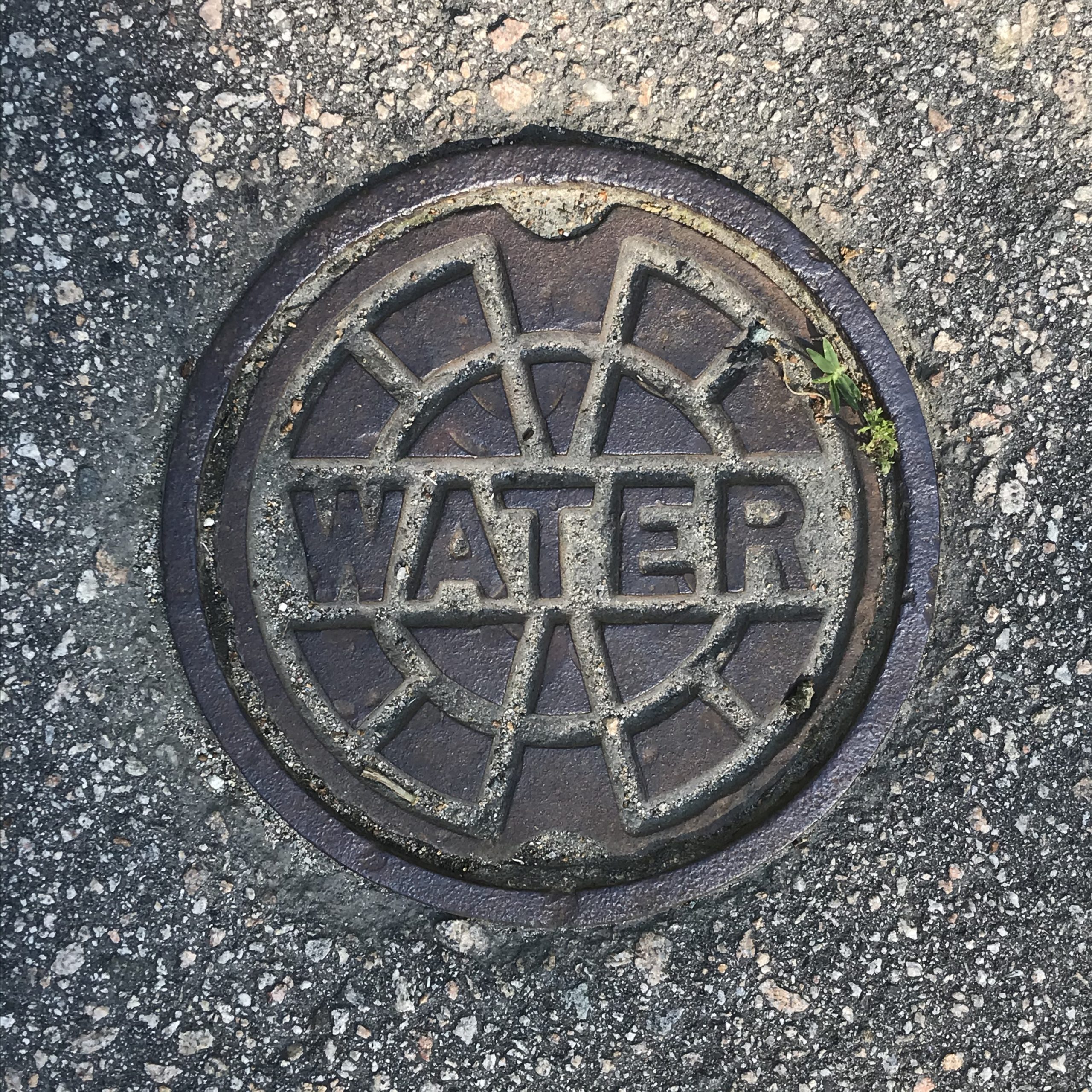
To upgrade or not to upgrade? That is the question
Around 2010, the Albuquerque Bernalillo County Water Utility Authority (Water Authority) faced a problem familiar to most utilities: many of its water meters were past or approaching their 20-year life expectancy. Because accuracy declines and maintenance issues increase as meters age, older meters may adversely impact revenue. The Water Authority’s older meters were due for replacement. Since metering technology had substantially advanced in the prior two decades, the Water Authority now faced a decision: replace their meters with conventional meters, expand their current meter replacement program using automatic meter reading (AMR) technology, or upgrade their meters and network system to advanced metering infrastructure (AMI). Upgrading to AMI would be no minor investment. Given the expense and long life of water infrastructure, the Water Authority faced a multimillion-dollar question with operational implications for the next several decades, as well as the opportunity for additional benefits that might or might not lead to a positive return on investment over time.
A short introduction to water meters
Conventional water meters are read manually by a meter reader who must visit each metered establishment to record the water usage displayed on the dial of the meter ahead of the billing cycle. If a user’s meter is inaccessible when the reader visits, the utility bill reflects estimated water use. Automatic meter reading (AMR) technology simplifies the logistics considerably: an AMR-equipped meter transmits its water usage reading electronically when the reader walks or drives past with a remote reading device. In the mid-to-late 1980s water utilities across the U.S. started phasing in AMR, and in the mid-2000s the Water Authority had begun deploying drive-by AMR technology for new water customers and old meter replacements.
Less than 20 years after the birth of AMR, metering technology was evolving quickly and advanced metering infrastructure (AMI) entered the scene. AMI-enabled meters are used by electric, gas, and water utilities and allow two-way communications between the utility and the meter and build a much more data-rich environment for utilities and their customers. They transmit usage data in near-real time via dedicated channels such as Fixed Radio Frequency (RF) networks, Broadband over Power Line (BPL), Power Line Communications (PLC)[1], and public networks (e.g., landline, cellular, paging).[1] Data are received by the AMI host system at the utility and transmitted to a Meter Data Management (MDM) system that stores data and manages it for further analysis. Smart metering took off in the electric sector early in the 2000s, boosted by dynamic pricing and deregulation-enabled shifts in electricity markets,[2] growing from about 6.7 million advanced meters in 2007 to over 70 million by 2016.[3] Less visibly and around the same time, water utilities were also starting to pilot advanced metering infrastructure (AMI). A decade later, when the Water Authority was considering these technology trends, they had to consider sticking with their AMR roll-out, or risk joining a handful of early adopters and start shifting towards AMI.
Who is the Water Authority?
Albuquerque’s Water Authority is the largest water and wastewater utility in New Mexico, the most arid state in the U.S.,[4] where water is a precious resource (refer to Table 1 for Water Authority facts). The utility’s mission is three-fold: (a) assure responsive customer service; (b) provide reliable, high quality, affordable, and sustainable water supply, wastewater collection, treatment, and reuse systems; and (c) support a healthy, environmentally sustainable, and economically viable community. Sustainability features prominently in this mission, a feature that shapes the water authority’s decisions.

Table 1: Fast facts about Albuquerque’s Water Authority[5]
The Water Authority’s smart metering decision
Which option did the Water Authority choose when it faced the strategic decision point in 2010 of how to upgrade its meters? Motivated by the need to increase revenue, improve customer service, and support conservation efforts, the water authority investigated AMI system options. Hobert “H” Warren, an New Mexico native with 23 years of water utility experience, is the Water Authority’s Field Operations Manager. H is intimately familiar with the utility’s meter technologies as he’s been involved throughout the transition from conventional to AMR to AMI meters. He served as the chair of the of the ad-hoc committee that issued the Request for Proposal and performed the cost-benefit analysis (CBA) to compare multiple AMI systems. The Proposal and CBA led the Water Authority to initiate a program of AMI ‘smart meter’ installations and select Sensus as their AMI system vendor in 2011, becoming one of the water sector’s early adopters of AMI technology. Smart water meters (both AMR and AMI) had a slow start in the water sector but have taken off in the last decade; the market share of meter sales revenue from smart meters in the U.S. has increased from 22% (2012) to 41% (2018).[6]
Since then, the Water Authority has been replacing old, conventional meters and upgrading more recent, drive-by AMR meters to a radio-equipped AMI system capable of 2-way communication. In phase 1 (2011), the utility started by installing five FlexNetTM Tower Gateway Base (TGB) stations (expanding to nine in later phases) and replacing 1000 large meters, which represented 20-30% of their revenue. The goal of phase 2 (2012-2013) was to get 50,000 small, residential AMI-enabled meters running within two years so that they could start to see and measure the impacts of putting AMI data to use. Phase 2 started by registering the approximately 40,000 newer AMR meters with the AMI system. In phases 3 and 4, the Water Authority prioritized its employees’ safety by switching out meters in the most dangerous or hazardous locations and routes first. By the end of 2019, the Water Authority had converted 49% of its meters to AMI and, with annual capital improvement plan (CIP) funding of $2 million, is moving forward to replace all remaining conventional meters with AMI meters. Figure 1 shows a graph of AMI annual installations between 2011-2019, and Figure 2 displays a map of AMI meters installations across Albuquerque to date.
The full system, which is expected to be completed between 2025 and 2027, will ultimately include nine FlexNetTM TGB stations and 400-600 repeaters across the Rio Grande valley that transmit data between approximately 200,000 FlexNetTM AMI-enabled smart meters and the utility in the Water Authority’s service area.
In the sections that follow, we’ll examine the benefits they’ve experienced and take a look at how the Water Authority is implementing its AMI initiative.
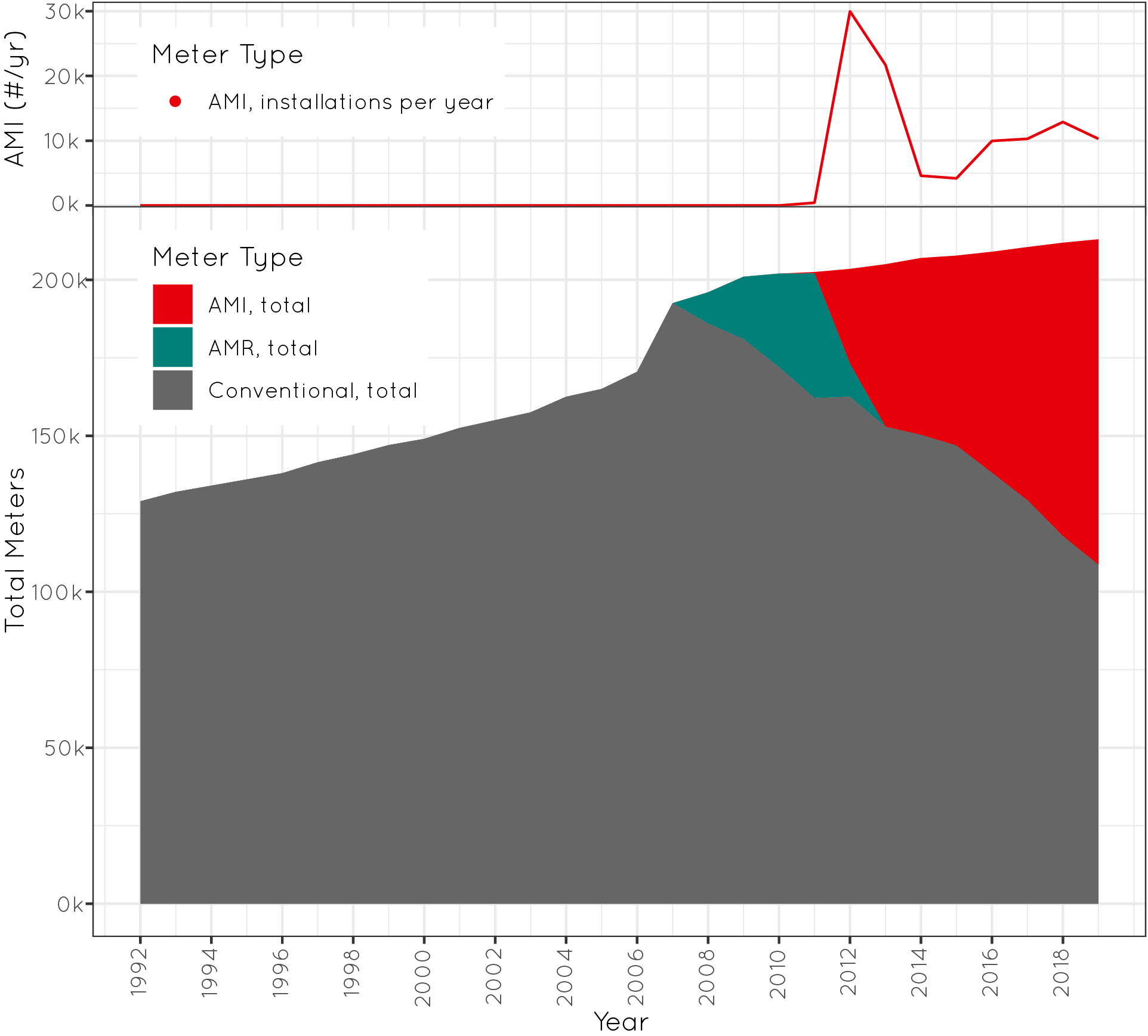
Figure 1: Water Authority conventional, automatic meter reading (AMR), and advanced metering infrastructure (AMI) meters over time (1993-2019). Top panel: Number of AMI installations per year (includes upgrading the registrations of AMR meters to AMI)[7].Bottom panel: Estimates of total number of conventional, AMI, and AMR accounts over time.[8]
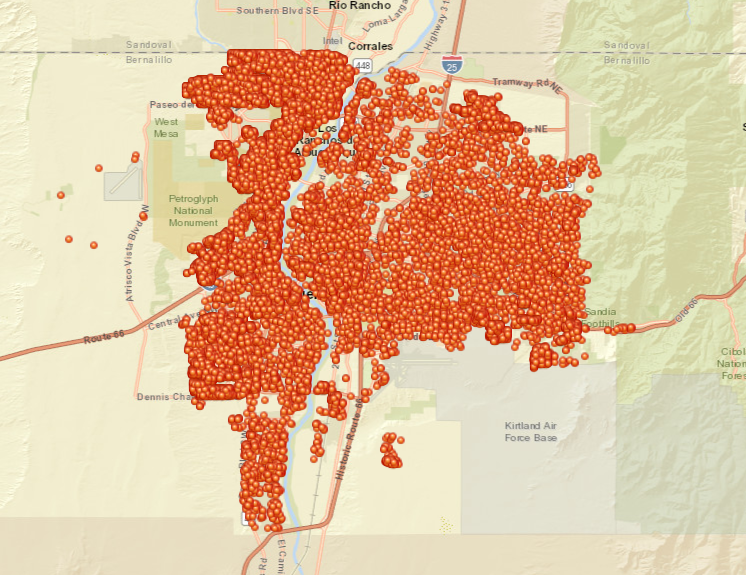
Figure 2: Map of ABCWUA installed AMI meters in Albuquerque.[9]
The benefits of smart metering with AMI technology in Albuquerque
Albuquerque’s Water Authority has seen smart metering benefits across multiple levels, ranging from the technical specifics of meter operations all the way to overall utility sustainability (Figure 3).
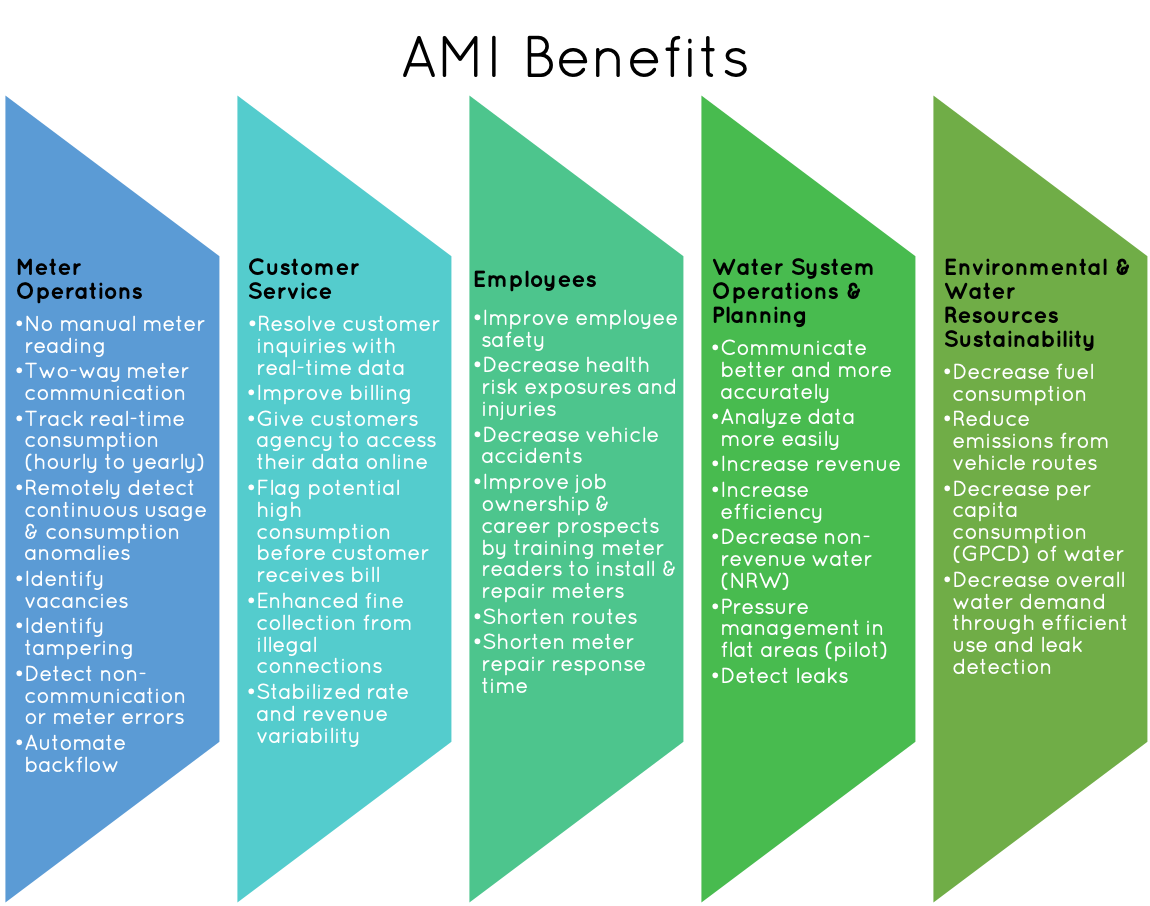
Meter operations
At the level of the individual water connection, AMI meters offer enhanced efficiency, accuracy, and labor savings compared to a conventional meter, and they provide much more detailed data about water usage.
- Better water usage measurements: AMI meters save time and manpower to read meters, and they improve the accuracy of meter readings. It takes 70 seconds to read a conventional meter with 97% accuracy. In contrast, the remote reading for an AMI meter takes 1/7th of a second and is 99.97% accurate. At these rates, it takes the Water Authority about 2000 hours to read half of its meters (the older, conventional ones), and only about 4 hours to read the other half (the AMI meters).[10]
- Better communication: The two-way, remote communication capabilities of AMI meters allow the utility to turn them on and off, flush them, and update their software remotely. In contrast, AMR and conventional meters require site visits for drive-by communication and manual reading, respectively. Near real-time data from AMI meters also facilitate quick field responses that include virtual metering, mobile alerts, and shorter meter routes.
Employees
The benefits for Water Authority employees appeared early in implementation and have continued to grow as the proportion of AMI meters has increased.
- Health and safety: Eliminating manual meter reading reduces work-related injuries from slips and falls, handling heavy manhole covers and equipment, violent attacks (whether by dogs or humans), vehicle accidents, extreme weather exposure, and repetitive motion injuries. It also prevents stressful encounters with agitated customers, bad traffic, dangerous construction sites, and the like.
- Career prospects: To prevent job loss among manual Meter Readers, the Water Authority provided additional training for line maintenance and meter installation through their utility technician program. They learn to do full “turnkey” work, such as fixing leaks and repairing or replacing meters. Following training, Meter Readers are promoted to Utility Technicians and grow their career within the organization. With the promotion, their maximum hourly pay also increases.
- Effectiveness and leadership: The Water Authority manages and analyzes the data resulting from the AMI system in-house. Their chief engineers, foremen, and superintendents receive training in data analytics, which improves their job effectiveness and gives them the opportunity to lead new internal projects. For example, a chief engineer is working with a technology partner to customize system dashboards for the utility’s needs, supporting a transition from troubleshooting and repair towards understanding and prevention of certain technical issues.
Customer Service and Affordability
Integrating AMI into the internal and public-facing processes of the utility has improved the resolution of customers’ inquiries, facilitated water and cost savings in continuous use cases, and stabilized water rates.
- Engaged, efficient workforce: By training meter readers to replace and fix meters, ABCWUA has created a valued, engaged workforce. These employees feel ownership in the AMI system, and have the skills and motivation to give better customer service. Fewer conventional meters to be read translates to shorter routes with more schedule flexibility to make repairs. As a result, response times to repair a stopped meter have decreased from up to 6 months (pre-AMI) to 24-48 hours (post-AMI).
- Inquiry resolution: The Water Authority has retrained customer care representatives to be more responsive to customer inquiries. Access to high-frequency historic data on customer water use from the AMI system allows representatives to identify the dates of high-usage events and ask follow-up questions to identify common causes (e.g., filling a swimming pool) or help to diagnose potential problems (e.g., leaks) that can contribute to high water bills.
- Cost savings: Continuous, uninterrupted water usage is often the sign of a leak. AMI meters enable real-time, remote detection of and automatic alerts for continuous usage. This enhanced detection of continuous usage reduces water waste, and the resulting cost savings accrue to both the customer and utility. In 2019, the Water Authority flagged 99 accounts with continuous water usage and was able to help 78 of those customers fix the source of the problem, saving 42,000 gallons of water per hour.
Water system operations & planning
Smart metering with an AMI system allows the Water Authority to measure water usage and the state of their distribution system faster and more intelligently, supporting their mission to provide “reliable, high quality, affordable and sustainable water supply […] systems.” The AMI system has also provided a quick return-on-investment (ROI), largely through water efficiency improvements such as the identification of continuous use cases, improvement of meter inaccuracies, and reduction in non-revenue water.
- Analyze operational efficiency: The utility stores AMI meter readings in a Meter Data Management (MDM) system that facilitates further analysis of usage. ABCWUA has put this data to use to optimize the delivery of water to specific zones and grids, and to make water efficiency improvements by analyzing changing consumption patterns (as well as previously-mentioned continuous usage detection).
- Decreasing non-revenue water generates revenue: According to Dan Pinney of Sensus,[11] AMI systems can be a key tool to decreasing the apparent or “commercial” water loss component of non-revenue water. Apparent losses describe water that is produced by the utility and used by a customer, but not measured or paid for. AMI systems help address these losses by improving meter accuracy, reducing billing and data handling errors, and reducing unauthorized connections. As an old water meter fails, it reads low, showing less usage than has actually occurred. As part of a UtiliWorks and Water Authority study[12] on meter performance, identifying and replacing approximately 3000 broken and low-functioning water meters with AMI meters allowed the utility to improve its billing accuracy. Eliminating defective and stopped meters captured approximately $2.5 million in lost revenue over a three-year period and decreased number of meter repair visits. According to the AWWA Water Audit Data Initiative (WADI), between 2011 and 2015, the Water Authority’s annual apparent losses decreased from approximately 929 million gallons (MG) per year to approximately 93 MG/year and the apparent losses per service connection per day decreased from 12.48 to 1.22 gallons per connection per day, the second lowest in the WADI sample of 29 utilities with an average apparent loss of 10.9 gal/conn/day.[13][14]
- Improve pressure monitoring: To leverage their AMI investment beyond meter reading, the Water Authority began a pressure monitoring pilot, which will be expanded based on its success. Its purpose is “to detect system anomalies, proactively respond to issues, and generally manage their system more strategically,”[15] according to Joel Berman, the Chief Engineer in the Field Operations Division, who leads the pilot along with the project foreman. The pilot takes place in a problematic reduced pressure zone east of the river that requires pressure relief valves (PRVs) to govern the pressure, and uses pressure sensors and Sensus ally® water meters to measure and monitor pressure and the Sensus® Smart Gateway Sensor interface to remotely read pressure data and detect PRV failures. Now, small pressure changes (e.g., 5-10 psi) are observable and crews can be quickly dispatched to identify, repair, and prevent further breaks.
As the Water Authority continues its smart meter initiative, it’s looking at ways to further leverage the capabilities of advanced metering. Data generated by the AMI system could support future improvements to the water system:
- Distribution system technology: If the growing city of Albuquerque expands into flatter areas where gravity-driven water supply is less efficient, the Water Authority may need additional pressure management for future expansions of the water supply system. The utility is also following the technical development of advanced leak detection software and equipment. Both pressure management and leak detection applications can be enhanced in a water supply system with AMI.
- Advanced analytics: AMI generates a large and rich data set. In the next AMI phase, the Water Authority will release a request for proposal (RFP) for third party software to extract further value from their data. Techniques such as data mining, machine learning, and artificial intelligence have potential to support tools for predictive maintenance, management analytics, and detection of inaccuracies in customer data.[16]
Water Resources and Environmental Sustainability
The Water Authority cares about the sustainability of its operations, its community, and its water resources. AMI supports the utility’s efforts to improve water efficiency, decrease the demand on limited local water resources, and reduce greenhouse gas emissions.
- Decrease in per capita water usage: Beyond reducing water waste through timely detection of continuous usage, real-time high-frequency water meter data empower customers to understand their water bills and adjust their water usage accordingly. AMI meters thus complement other water efficiency and conservation initiatives, such as public education, low use-based incentives, and the promotion of water-efficient appliances and fixtures. As illustrated in Figure 4, the average water consumption in Albuquerque was 252 gallons of water per person per day in the mid-1990s. As a condition of the state permit for construction of the San Juan-Chama Drinking Water Project (2004-2008),[17] the Water Authority was required to reduce this usage to 155 gallons per capita per day (GPCD) by 2014. They surpassed the target, decreasing usage to 150 GPCD in 2011. Through the combined effects of a multi-prong approach that included AMI, average per capita daily water use dropped from 150 gallons at the start of the utility’s AMI program in 2011 to 121 GPCD in 2019. This aggressive conservation strategy continues: the Water Authority has set a new target to reduce usage to 110 GPCD by 2037.
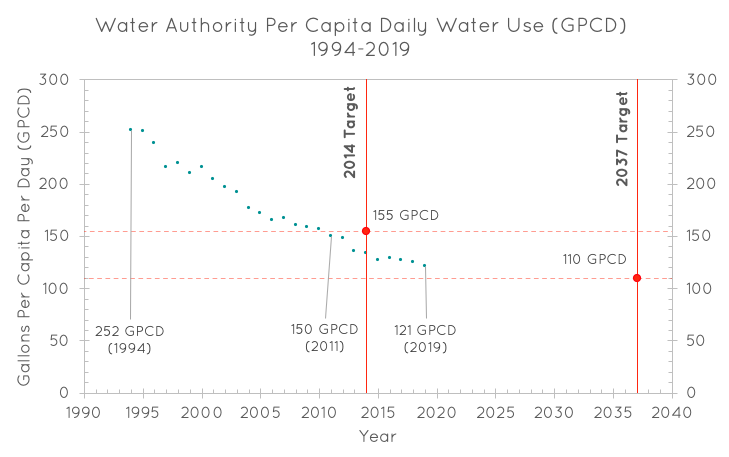
Figure 4: Water Authority per capita daily water use in gallons per capita per day (GPCD) from 1994 to 2019 in comparison to 2014 and 2037 (WATER 2021) targets.[18]
- Decreased fuel consumption and tailpipe emissions: Nearly half of the Water Authority’s meters now use AMI technology, which report data remotely without requiring an employee to drive to the meter for a visual or AMR reading. With shorter trips and the number of vehicles on the road reduced by half to 24 between 2011 to 2019, the utility has reduced vehicle maintenance needs, fuel consumption, and tailpipe emissions.
Looking Forward
As the AMI system has expanded in Albuquerque, changes galvanized by the data and technology it provides to the Water Authority are improving the services to their customers, the lives and jobs of utility employees, the organization’s daily operations and long-term planning, and the utility’s sustainability profile. Hidden away in utility boxes and underground meter enclosures are the upgraded water meters that help inform and support the Water Authority’s usage reduction efforts and overall strategy.
On the surface, meter upgrades sound purely technical, but they have led to system-wide benefits, helping the water authority to better fulfill its mission when part of a holistic approach that prioritizes people and services over technology. Klarissa Peña, Chair of the Board explained, “[Upgraded meters] are not related to growth. They are needed to provide safe and reliable service at the level that our existing customers have come to expect, to protect the environment and surrounding communities, and to ensure an adequate drinking water supply.”[19]
The needs, context, and resources of every utility is different. Considering a new technology such as AMI or AMI requires a thoughtful approach and research to determine whether it is wise or timely. If your utility is interested in AMI, we encourage you to reflect on how it can be systematically and holistically incorporated.
Further information on AMI/AMR vendors
The following list of AMI/AMR vendors is provided for further information, but does not reflect endorsements by the Internet of Water nor does it claim to be comprehensive. Corrections and updates may be emailed to internetofwater@duke.edu.
Though AMI technologies are listed below, most AMI vendors have both AMR and AMI meter technologies available.
- Aclara STAR® AMI technology
- Arad Group Dialog3G
- Badger BEACON® Automated Metering Analytics
- Elster Falcon PR and PR& Registers
- Itron ChoiceConnect™ AMI
- Kamstrup AMI
- Mueller Mi.Net AMI system
- Neptune AMI
- Sensus FlexNet® AMI technology
Acknowledgements
This data story would not have been possible without the information and time generously provided by H Warren at Albuquerque Bernalillo County Water Utility Authority (ABCWUA).
Thank you to all who contributed to this story by providing data, insights, and suggestions.
- Hobert “H” Warren, Field Operations Manager, ABCWUA
- Frank Roth, Senior Policy Manager, ABCWUA
- David Morris, Public Affairs Manager, ABCWUA
- David Sayers, Manager, Black and Veatch Management Consulting, LLC
- Kim Genardo, Senior Corporate Communications Manager, Sensus, Xylem Inc.
- Jessica Lawson, Ph.D., Independent Consultant
- A.R. El-Khattabi, Ph.D., University of North Carolina at Chapel Hill
Questions/Comments?
Please direct all comments and inquiries about this data story to internetofwater@duke.edu (attn: Kristen Downs).
Method Tags: N/A
Use Case Tag: water quantity, water quality, water use, infrastructure
Organization Tags: utilities
Benefits Tags: Return on Investment, Water Savings, Time Savings, Increased Productivity, Improved Decision-Making, Accurate Design and Integrated Operations
For more information:
[1] Electric Power Research Institute (EPRI). 2007. Advanced Metering Infrastructure (AMI).
[2] For more information on the growth of advanced meters in the electric sector and the relationship between dynamic pricing and AMI refer to: (i) Federal Energy Regulatory Commission. 2018. 2018 Assessment of Demand Response and Advanced Metering: Staff Report.; (ii) Walton, R. 2018. Smart meter deployments slow as questions emerge over cost effectiveness, saturation. Utility Dive.; (iii) Tweed, K. 2011. Smart Grid: Dynamic Pricing and AMI for All by 2030? Green Tech Media.
[3] Federal Energy Regulatory Commission. 2018. 2018 Assessment of Demand Response and Advanced Metering: Staff Report, Table 2-2, p. 4.
[4] The land-to-water ratio of New Mexico is 0.24%, the lowest of the 50 U.S. states. USGS. How Wet is Your State? The Water Area of Each State. Retrieved February 7, 2020.
[5] ABCWUA fast facts data sources: ABCWUA. 2014. Water and Infrastructure: The Price of Delivering a Priceless Resource.; ABCWUA. 2019. Channeling Success: A Decade of the San Juan-Chama Drinking Water Project. 2019 Annual Report.; ABCWUA. 2019. Implementing AMI: Project Insights. PowerPoint WCCF Presentation. Received through email correspondence from Frank Roth (ABCWUA).; Cottrell, B.; Berman, J.; Poss, J.; Thomson, C. 2019, April 18. Going Beyond AMI: Customer Success Stories, slide 34. Sensus Webinar.; telephone communication with H Warren (ABCWUA).
[6] StatPlan Energy Ltd. 2019. Water Meter Report Ed 2 2019: Utility Meters, C&I Meters, Bulk Meters, Residential Meters, Digitisation, Blockchain, AMI and AMR Sub Meters.
[7] ABCWUA. 2019. Implementing AMI: Project Insights. PowerPoint WCCF Presentation, slide 12.
[8]The data presented in the bottom panel of Figure 1 reflect estimates and should not be used or cited. Sources for data used to estimate the annual counts of conventional, AMR (automated meter reading), and AMI (advanced metering infrastructure) meters by year include: ABCWUA. 2019. AMI: More Than Meter Reading. Powerpoint presentation, slide 8. Received through email correspondence from H Warren (ABCWUA).; ABCWUA. 2019. Implementing AMI: Project Insights. PowerPoint WCCF Presentation, slides 13 and 15. Received through email correspondence from Frank Roth (ABCWUA).; Gates, G. and Stomp, J. 2019. Groundwater Management – The Cornerstone of Albuquerque’s 100-year Water Resources Plan. Hazen and Sawyer.; ABCWUA. 2016. Approved FY2016 Budget.; ABCWUA. 2019. Proposed FY2020 Budget.; ABCWUA. 2018. Approved Fiscal Year 2009 Budget, p. 109. Assumptions based on telephone communication with H Warren (ABCWUA): the first AMI installations were 1000 large meters (traditional) and 40,000 AMR meters.
[9] Davidson, P. 2015. Location of ABCWUA Installed AMI Meters. Map of Locations of Installed AMI Meters in ABCWUA Service Area. ABCWUA.
[10] ABCWUA. 2019. Implementing AMI: Project Insights. PowerPoint WCCF Presentation. Received through email correspondence from Frank Roth (ABCWUA).
[11] Penney, D. 2018, February 20. Stem the Tide of Non-Revenue Water. Water Finance & Management (WaterFM).
[12] Utiliworks and ABCWUA. (2012, June 18). Analysis of Small Meter Maintenance within ABCWUA. 28 pages.
[13] 2011-2015 WADI data for ABCWUA provided by David Sayers of Black & Veatch Management Consulting, LLC (personal correspondence).
[14] Sayers, D. 2017, Dec 3-5. Building Trust in Water Audit Data Validity, Volume, and Value. Presentation at North American Water Loss 2017, San Diego, California.
[15] Cottrell, B.; Berman, J.; Poss, J.; Thomson, C. 2019, April 18. Going Beyond AMI: Customer Success Stories, slide 35. Sensus Webinar.
[16] Examples of advanced analytics include predictive maintenance and management analytics (e.g., tools developed by Splunk and Fracta) and tools to identify inaccuracies from customer metering and customer data handling (e.g., the Hidden Revenue Locator™ by Valor Water).
[17] ABCWUA. San Juan Chama Project.
[18] GPCD data sources: ABCWUA Water Use Graph (Gallons Per Capita Per Day); ABCWUA Latest News; and ABCWUA Consumers: Learning to Save Water.
[19] ABCWUA. 2014. Water and Infrastructure: The Price of Delivering a Priceless Resource.
